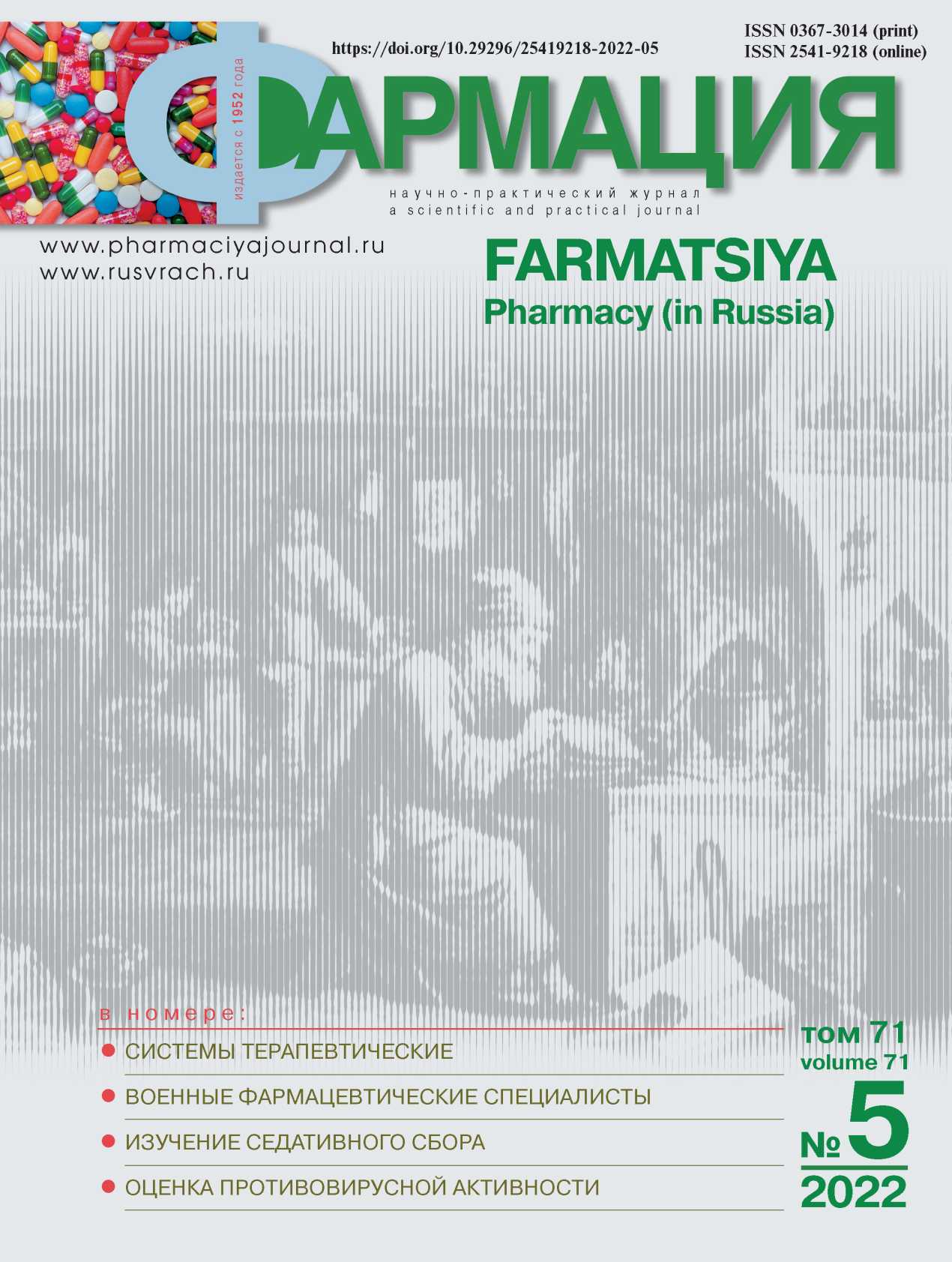Determination of the size of fat droplets in emulsions for parenteral use
- Authors: Gunar O.V.1, Dorenskaya A.V.1
-
Affiliations:
- Federal State Budgetary Institution "Scientific Center for Expertise of Medicinal Products" of the Ministry of Health of Russia
- Issue: Vol 71, No 5 (2022)
- Pages: 11-17
- Section: Pharmaceutical chemistry and pharmacognosy
- URL: https://journals.eco-vector.com/0367-3014/article/view/113742
- DOI: https://doi.org/10.29296/25419218-2022-05-02
- ID: 113742
Cite item
Abstract
Introduction. In medical practice, emulsions for parenteral use are widely used, which are a complex dispersed system with different quality requirements.
Objective: consideration of some aspects of determining the size of fat droplets in emulsions for parenteral use.
Material and methods. The objects of study are emulsions for parenteral use. For tests, a particle counter "MultisizerTM - 3 Coulter Counter" and a BX41 Olympus binocular microscope equipped with an eyepiece - micrometer were used. For additional lighting, the KL 1500 LCD illuminator. GF RF, USP, EPh.
Results. The study of literary materials and pharmacopoeial documentation gives an idea of the requirements for the quality of medicines (drugs) in terms of "particle size" and methods of their analysis. For the experimental estimation of particle sizes, the methods of electrosensitive zones (ESZ) and optical microscopy were used, which, according to the results of comparative statistical calculations, can in some cases complement each other, but in fact, the instrumental method of ESZ is preferable.
Conclusion. The ESZ method is applicable to the determination of particle size in emulsions for parenteral use. Studied for the period 2015-2021 the quality of the medicinal product in terms of "particle size" meets the requirements of normative documents.
Full Text
About the authors
Olga Viktorovna Gunar
Federal State Budgetary Institution "Scientific Center for Expertise of Medicinal Products" of the Ministry of Health of Russia
Author for correspondence.
Email: gunar@expmed.ru
PhD in pharmaceutical Sciences, Head of the Microbiology Laboratory
Anna Viktorovna Dorenskaya
Federal State Budgetary Institution "Scientific Center for Expertise of Medicinal Products" of the Ministry of Health of Russia
Email: dorenskaya@expmed.ru
PhC in pharmaceutical Sciences, Chief Expert of the Microbiology Laboratory
References
- Государственная фармакопея РФ XIV изд, том 2 [Электронный ресурс]. Режим доступа: https://docs.rucml.ru/ feml/pharma/v14/vol2/
- Luis Otero-Millan, Natividad Lago Rivero, Antia Blanco Rodicio, Nerea Garcia Beloso, Jose Luis Legido Soto, Guadalupe Pineiro-Corrales, Stability of lipid emulsion in total parenteral nutrition: An overview of literature, Clinical Nutrition ESPEN. 2021; 45: 19-25. ISSN 2405-4577, https://doi.org/10.1016/]. clnesp.2021.06.027.
- David F. Driscoll, Pei-Ra Ling, Bruce R. Bistrian, Pharmacopeial compliance of fish oil-containing parenteral lipid emulsion mixtures: Globule size distribution (GSD) and fatty acid analyses, International J. of Pharmaceutics. 2009; 379 (1): 12530. ISSN 0378-5173, https://doi.org/10.1016/jAjp-harm.2009.06.021.
- Патент №2593779 C1 Российская Федерация, МПК G01N 33/15. Способ измерения количества и размеров жировых капель в лекарственных препаратах для парентерального применения: №2015120469/15: заявл. 29.05.2015: опубл. 10.08.2016 (О. В. Гунар, Е. С. Новик, А. В. Доренская); заявитель Федеральное государственное бюджетное учреждение "Научный центр экспертизы средств медицинского применения" Министерства здравоохранения Российской Федерации (ФГБУ "НЦЭСМП" Минздрава России). EDN DWBZZL
- Koster V.S., Kuks P.F.M., Lange R., Talsma H. Particle size in parenteral fat emulsions, what are the true limitations? International J. of Pharmaceutics. 1996; 134 (1-2): 235-8. ISSN 0378-5173, https://doi.org/10.1016/0378-5173(95)04409-4.
- David F. Driscoll, Frank Etzler, Thomas A. Barber, Jorg Nehne, Wilhelm Niemann, Bruce R Bistrian, Physicochemical assessments of parenteral lipid emulsions: light obscuration versus laser diffraction, International J. of Pharmaceutics. 2001; 219 (1-2): 21-37. ISSN 0378-5173, https://doi.org/10.1016/S0378-5173(01)00626-3.
- Marko Krstic, Dorde Medarevic, Jelena Duris, Svetlana Ibric, Chapter 12 - Self-nanoemulsifying drug delivery systems (SNEDDS) and self-microemulsifying drug delivery systems (SMEDDS) as lipid nanocarriers for improving dissolution rate and bioavailability of poorly soluble drugs, Editor(s): Alexandru Mihai Grumezescu, Lipid Nanocarriers for Drug Targeting, William Andrew Publishing. 2018; 473-508. ISBN 9780128136874, https://doi.org/10.1016/B978-0-12-813687-4.00012-8.
- Driscoll D.F. Physicochemical assessments of parenteral lipid emulsions: light obscuration versus laser diffraction (D.F. Driscoll, F. Etzler, T.A. Barber, J. Nehne, W. Niemann, B.R. Bistrian).Int J. Pharm. 2001; 219: 21-37.
- Brans Y.W. Tolerance of fat emulsions in very low birth-weight neonates: effect of birthweight on plasma lipid concentrations (Y.W. Brans, D.S. Andrew, D.W. Carrillo, E.B. Dutton, E.M. Menchaca, B.A. Puelo-Scheppke). Am. J. Perinatol. 1990; 7: 114-7.
- Driscoll D.F. Stability of total nutrient admixtures with lipid injectable emulsions in glass versus plastic packaging (D.F. Driscoll, A.P. Silvestri, B.R. Bistrian, B.A. Mikrut). Am. J. Health Syst Pharm. 2007; 64: 396-403.
- Driscoll D.F. The effects of packaging containers on the large-diameter tail of the globule size distribution (GSD) of lipid emulsions (D.F. Driscoll, B.R. Bistrian). Clin Nutr. 2005; 24: 699.
- United States Pharmacopeia Online. [Electronic resource]. Access mode: https://www.uspnf.com/(circulation date 02/10/2021)
- European Pharmacopoeia Online. European Directorate for the Quality of Medicines, 2021. [Electronic resource]. Access mode: https://online.edqm.eu/(circulation date 12/11/2021).
- Доренская А.В. Применение метода электрочувствительных зон в фармацевтическом анализе: специальность 14.04.00 "Фармацевтические науки": диссертация на соискание ученой степени кандидата фармацевтических наук. Санкт-Петербург, 2015; 139.
Supplementary files







